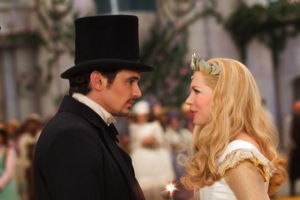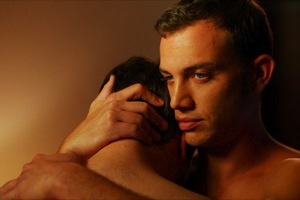
Oz the Great and Powerful
When I was a kid, CBS would show The Wizard of Oz every March, and my parents would let my brother and me stay up way past our bedtime to see it. (We had to brush our teeth and get into our pajamas first.) While Star Wars, Superman, and ET were all released and re-released during my early childhood, they did not – and no other movie has – match the sheer wonder and joy that The Wizard of Oz brought to me. The moment that Dorothy opens the door of her house, after it was been thrown through the sky by a Kansas tornado and landed in Oz, and the black, white and very gray world becomes not just Technicolor, but incandescent and utterly alive is, to me, one of the greatest moments in film history.
That Sam Raimi, in his quite wonderful and extraordinarily gorgeous prequel Oz the Great and Powerful, is able to pay homage to that moment and nearly equal its experience is the greatest surprise I’ve had at the movies in many months.
Not to be confused with any of the other prequels and sequels that have cropped up since Frank L. Baum’s novel entered the public domain (most notably the novel and musical Wicked), Oz the Great and Powerful is the story of how the wizard (James Franco) ended up as the ruler of the Emerald City; how he is transformed from Oscar Diggs, a huckster magician in a travelling circus in 1905 Kansas, into the prophesied savior of Oz.
The simple answer is that a tornado strikes just as Oscar, known as Oz, is escaping a few wronged carnies in a hot air balloon, and somehow the violent storm takes him to Oz, where the introduction of color, of Oz’s stunning landscapes, flora and fauna, is simply jaw-dropping. (My jaw actually dropped. 3-D hasn’t been used this well since Avatar.)
He is immediately found by Theodora (Mila Kunis), a raven-haired and stunningly naive good witch who tells him he is Oz’s new king and destined save the land from the wicked witch. Then she falls in love with him. Oz, however, has no magical powers, just a desire for money, women and fame. His change into someone who resembles who was prophesied, while unmasking bad witches and impressing good witches and ultimately saving the land of Oz, is the film’s arc. By the end, we know just about everything we need to know to understand The Wizard of Oz.
That screenwriters Mitchell Kapner and David Lindsay-Abaire are able to do this without infringing on Warner Bros.’ absurd copyrights on the ruby slippers, the swirl of the Yellow Brick Road in Munchkinland, or, most ridiculously, the shade of green and the mole on the Wicked Witch of the West’s face is impressive. However, since it takes a while to hit all of the plot points, the film drags in a couple places; I think it’s about 15 minutes too long.
Even with its extended length, the action, much of it involving winks to The Wizard of Oz’s most iconic scenes, is exciting, amazing and only occasionally scary. I think the original film’s flying monkeys are scarier that this one’s flying baboons.
Franco is well cast as Oz, since his sly, winking humor is perfect for a vaudeville swindler. As the witches, Kunis, Rachel Weisz (as Theodora’s sister Evanora), and Michelle Williams (as Glinda) are all beautiful and charismatic, though Williams and especially Weisz are so good that Kunis ends up seeming a bit amateurish, especially during her major dramatic scenes at the end of the film.
Much better than the human stars are Oz’s computer generated sidekicks, particularly Finley, the sweet flying monkey (voiced by Zach Braff), and the little girl made of china (Joey King) who Oz repairs, saves and befriends after her family and town are destroyed by the Wicked Witch’s flying baboons.
Her sweetness, wit and pain are the rawest and most powerful parts of the film. She made me yearn for more. In order for Oz the Great and Powerful to be able to reach the profundity of The Wizard of Oz, it needed a louder, deeper emotional resonance.
Judy Garland’s astonishingly sympathetic performance can never be replicated, but focusing the film on a shallow, if magnetic con-man ensured that the film could only be a hit, not an endearing, enduring classic.
Also Playing: Yossi
In 2002, Eytan Fox gave the world Yossi & Jagger, a beautiful, sexy and deeply moving love story about two Israeli soldiers; it was the Hebrew Brokeback Mountain, and it came out four years before Ang Lee’s now-classic.

Ten years later, Fox decided to do something usually only seen on fan fiction sites. He made a sequel. And like Ryan’s Story, the ill-advised follow-up to the classic Love Story, Yossi was a bad idea, coasting on the memory and goodwill of the much better, much more powerful previous film.
Yossi, which follows one-half of the couple a decade later as he tries to break free of his broken, cloistered heart is not actually bad. As the titular character, Ohad Knoller, who has become somewhat of a bear, is too mopey, but when he lets himself feel again, it’s hard not to be moved.
As his new love interest, a young, extroverted and very out soldier named Tom, Oz Zehavi is no Yehuda Levi, who played Jagger, but Zehavi is magnetic and eager, the perfect antidote to Yossi’s depression. Fox has made better movies, but the sensitivity and subtlety of his direction makes this small, slight movie surprisingly rich.











